Year-End 2017 is Here!
 Ready or not, here year-end comes. With some organization and planning, however, it doesn’t have to be stressful. Let’s look at some critical tasks your firm should complete as part of the year-end process.
Ready or not, here year-end comes. With some organization and planning, however, it doesn’t have to be stressful. Let’s look at some critical tasks your firm should complete as part of the year-end process.
Preparing to Close 2017
First off, the most important task is to document your year-end procedures. Not only those performed in your Deltek system, but all of them so that you have a comprehensive guide to refer to on a year to year basis. You should also create a calendar and develop a year-end checklist as part of your year-end procedures.
Some of the more common year-end tasks for most companies are:
- Reconcile all cash accounts - Verify all transactions have been posted into Vision/DPS to ensure your general ledger balance matches your bank statements adjusting as required.
- Final invoicing – Process all client invoices for the fiscal year.
- Review outstanding accounts receivable - Follow up with clients who have outstanding accounts receivable beyond 30 days. Send past due statements and give them a call. Enter the results of your collection efforts in the comments section of Deltek Vision or Deltek for Professional Services (DPS) invoice review. Year-end is an excellent time to collect your outstanding receivables. If you determine there is uncollectable accounts receivable, be sure to write those invoices off.
- Review unbilled detail - Time and expense transactions that cannot be invoiced to clients should be written off at this time.
- Fixed assets – Fixed assets are larger purchases that are made throughout the year (i.e. equipment, automobiles, furniture, computers, etc.). Are all fixed assets reported on the balance sheet still owned? If not, record the sale or disposal of these fixed assets. Additionally, verify the depreciation on your fixed assets and make any necessary adjustments.
- Employee expenses and accounts payable - Verify that all accounts payable vouchers have been recorded in Vision or DPS. Make your 401(k), SEP IRA, and simple IRA contributions, if you have not done so. Also, try to pay all your vendors and employee expense reports by year-end.
- Notes payable - Verify notes payable (i.e. loans) amounts on your balance sheet match the statements from your lenders adjusting if necessary.
- W-9s – Order 1099 forms and make sure all W-9s from your vendors and/or contractors that are paid $600 or more throughout the year are on file. Don’t forget, 1099s should be mailed on January 31st. 1099 forms can be purchased from most office supply stores or you can order them for free from the IRS (gov).
- W-2s –If you run payroll in Vision or DPS, you’ll need to order W-2 forms which can be purchased from most office supply stores. W-2s should be mailed by January 31st.
- Budget for next year - Create your general ledger budget for 2018.
As part of the year-end process, a new benefit year will need to be opened to roll over any PTO or vacation time into the next year and to start accruals for the new benefit year.
Initialization Utilities in Deltek Vision and Deltek for Professional Services
There are numerous initialization utilities that need to be performed in Deltek Vision and DPS. Take note that these utilities need to be completed once per fiscal year. Vision and DPS will generate a posting log for the initialization utilities which is available in the transaction center under the posting review report. If your Vision or DPS database is set up with multi-company functionality, the initialization utilities need to run in each company. Make sure to watch this video for more information.
In Vision and DPS, opening the 1st period of your fiscal year also opens the new fiscal year. Depending on your security rights, you can still process in the prior fiscal year if needed.
Is Your Firm Ready for 2018?
Efficiently complete the tasks required for 2017 year-end, and you will be ready. If your firm is having any difficulties performing year-end tasks in Deltek Vision or DPS, Full Sail Partners can be of assistance! Also, remember to check out the new Deltek Customer Care portal for numerous resources available to you.



 At a recent client meeting, it was brought to light how many of my clients don’t use Deltek Vision’s approval engine capabilities. I thought how crazy that notion was because using the approval engine can save clients so much paper and time. Let me share with you what this firm experienced in dealing with approvals, and let’s see how many of you can think outside the box and see the benefits of Deltek Vision’s approval engine.
At a recent client meeting, it was brought to light how many of my clients don’t use Deltek Vision’s approval engine capabilities. I thought how crazy that notion was because using the approval engine can save clients so much paper and time. Let me share with you what this firm experienced in dealing with approvals, and let’s see how many of you can think outside the box and see the benefits of Deltek Vision’s approval engine.
 One of the main responsibilities of a project manager is managing the profitability of his projects. It is easy to look at hours charged to a project at billing rates minus the value of those hours at cost to see the gross profit of a project, but gross profit doesn’t give a true picture of profitability. Most firms prefer to look at net profit to measure the financial success of projects with net profit being hours at billing rates minus cost plus overhead.
One of the main responsibilities of a project manager is managing the profitability of his projects. It is easy to look at hours charged to a project at billing rates minus the value of those hours at cost to see the gross profit of a project, but gross profit doesn’t give a true picture of profitability. Most firms prefer to look at net profit to measure the financial success of projects with net profit being hours at billing rates minus cost plus overhead.
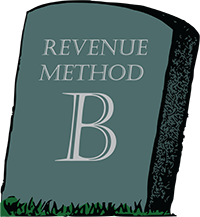 Revenue Method B is the most widely used revenue method in Deltek Vision. In fairness, this is Vision’s default method for projects whose charge type is Regular. As a result, most firms use it since it’s easy to deploy and seems to work, or so we think.
Revenue Method B is the most widely used revenue method in Deltek Vision. In fairness, this is Vision’s default method for projects whose charge type is Regular. As a result, most firms use it since it’s easy to deploy and seems to work, or so we think.

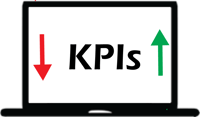 A KPI, or Key Performance Indicator, is a measurable value that demonstrates how effectively a company is achieving crucial business objectives. Organizations should use KPIs to evaluate their success at reaching targeted goals. Simply stated, KPIs provide your firm with metrics that compare budgeted amounts to the actual values. KPIs are no longer just for accounting and finance as they now reach deeper into a firm’s operational side examining marketing, business development and project management.
A KPI, or Key Performance Indicator, is a measurable value that demonstrates how effectively a company is achieving crucial business objectives. Organizations should use KPIs to evaluate their success at reaching targeted goals. Simply stated, KPIs provide your firm with metrics that compare budgeted amounts to the actual values. KPIs are no longer just for accounting and finance as they now reach deeper into a firm’s operational side examining marketing, business development and project management.
 Spend Management is a popular term, but what is it really? Spend Management can encompass anything from procurement, supply chain management, expense control, outsourcing and more. For most businesses, managing spending may not seem to provide a competitive advantage nor differentiate them from the competition. While this task doesn’t directly drive revenue, figuring out how to better manage and control your travel costs, expenses and invoicing does provide significant business value.
Spend Management is a popular term, but what is it really? Spend Management can encompass anything from procurement, supply chain management, expense control, outsourcing and more. For most businesses, managing spending may not seem to provide a competitive advantage nor differentiate them from the competition. While this task doesn’t directly drive revenue, figuring out how to better manage and control your travel costs, expenses and invoicing does provide significant business value.
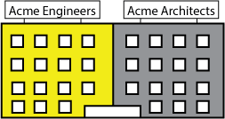 Within Deltek Vision lies a very handy tool, which enables a firm to have multi-company functionality. However, the benefits of this multi-company functionality feature seem to elude many firms that would greatly appreciate its capabilities. So let’s talk in detail about multi-company functionality and the why, when and how firms should use this fantastic feature.
Within Deltek Vision lies a very handy tool, which enables a firm to have multi-company functionality. However, the benefits of this multi-company functionality feature seem to elude many firms that would greatly appreciate its capabilities. So let’s talk in detail about multi-company functionality and the why, when and how firms should use this fantastic feature.
 Don’t be a headless chicken running around trying to get through the year-end process. Let’s review some considerations and tips to make your year-end close just a little easier.
Don’t be a headless chicken running around trying to get through the year-end process. Let’s review some considerations and tips to make your year-end close just a little easier.
 The Deltek Vision to Concur Connector allows both systems to work together seamlessly, automatically synchronizing finance data throughout the entire spending process, from pre-spend approval to reconciliation. Manage every expense and invoice transaction accurately and with ease, and get a complete view of your finances in one place.
The Deltek Vision to Concur Connector allows both systems to work together seamlessly, automatically synchronizing finance data throughout the entire spending process, from pre-spend approval to reconciliation. Manage every expense and invoice transaction accurately and with ease, and get a complete view of your finances in one place. 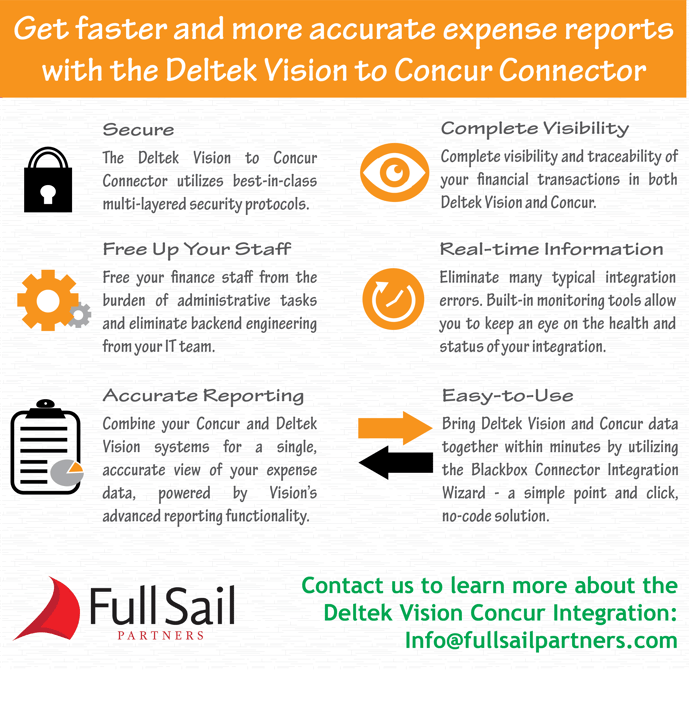

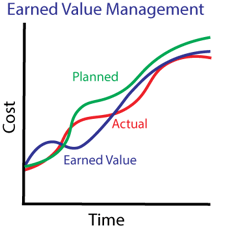 For project-based firms, measuring current firm performance is the most significant indicator of future firm performance. Furthermore, by using trend data, firms can forecast cost and schedule variances in the early stage of a project. A preferred method by project managers to factor this trend data is the earned value management technique.
For project-based firms, measuring current firm performance is the most significant indicator of future firm performance. Furthermore, by using trend data, firms can forecast cost and schedule variances in the early stage of a project. A preferred method by project managers to factor this trend data is the earned value management technique. 